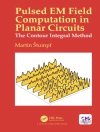A valuable addition to the Wiley Series in Microwave and Optical
Engineering
Today’s modern wireless mobile communications depend on adaptive
‘smart’ antennas to provide maximum range and clarity. With the
recent explosive growth of wireless applications, smart antenna
technology has achieved widespread commercial and military
applications.
The only book available on the topic of adaptive antennas using
digital technology, this text reflects the latest developments in
smart antenna technology and offers timely information on
fundamentals, as well as new adaptive techniques developed by the
authors. Coupling electromagnetic aspects of antenna design with
signal processing techniques designed to promote accurate and
efficient information exchange, the text presents various
mechanisms for characterizing signal-path loss associated with
signal propagation, particularly for mobile wireless communications
systems based on such techniques as joint space-frequency adaptive
processing.
In clear, accessible language, the authors:
* explain the difference between adaptive antennas and adaptive
signal processing
* Illustrate the procedures for adaptive processing using directive
elements in a conformal array
* clarify multistage analysis procedure which combines
electromagnetic analysis with signal processing
* present a survey of the various models for characterizing radio
wave propagation in urban and rural environments
* describe a method wherein it is possible to identify and
eliminate multipath without spatial diversity
* optimize the location of base stations in a complex
environment
The text is an excellent resource for researchers and engineers
working in electromagnetics and signal processing who deal with
performance improvement of adaptive techniques, as well as those
who are concerned with the characterization of propagation channels
and applications of airborne phased arrays.
Table of Content
Preface.
Acknowledgments.
Introduction.
What is an Antenna and How it Works.
Anatomy of an Adaptive Algorithm.
Direct Data Domain Least Squares Approaches to Adaptive
Processing Based on Single Snapshots of Data.
Elimination of the Effects of Mutual Coupling on Adaptive
Antennas.
Direction of Arrival Estimation and Adaptive Processing Using A
Nonuniformly Spaced Array from a Single Snapshot.
Estimating Direction of Arrivals by Exploiting Cyclostationarity
Using a Real Antenna Array.
A Survey of Various Propagation Models for Mobile
Communication.
Methods for Optimizing the Location of Base Stations for Indoor
Wireless Communication.
Identification and Elimination of Multipath Effects Without
Spatial Diersity.
Signal Enhancement In Multiuser Communication through Adaptivity
on Transmit.
Direct Data Domain Lease Squares Space-Time Adaptive.
Appendix A: The Concept of a Random Process and its
Philosophical Implications in Analyzing Communication Systems.
Appendix B: A Brief Survey of the Conjugate Gradient Method.
Appendix C: Estimation of the Direction of Arrival in One and
Two Dimensions Using the Matrix Pencil Method.
Index.
About the author
TAPAN K. SARKAR, Ph D, received a BTech from the Indian Institute of Technology, Kharagpur, India, an MSc E from the University of New Brunswick, Fredericton, Canada, and an MS and a Ph D from Syracuse University in Syracuse, New York, where he is currently a professor in the Department of Electrical and Computer Engineering. He is a fellow of the IEEE.
MICHAEL C. WICKS, Ph D, received undergraduate degrees from Mohawk Valley Community College and Rensselaer Polytechnic Institute, and graduate degrees from Syracuse University, all in electrical engineering. He is a Fellow of the IEEE and a member of the Association of Old Crows. Dr. Wicks is a Principal Research Engineer in the U.S. Air Force Research Laboratory in the Sensor Directorate, Radar Signal Processing Branch. He has authored over 125 papers, reports, and patents.
MAGDALENA SALAZAR-PALMA, Ph D, received an Ingeniero de Telecomunicación and a Ph D from the Universidad Politécnica de Madrid in Madrid, Spain, where she is a Profesor Titular in the Signals, Systems, and Radiocommunications Department at the Escuela Técnica Superiór de Ingenieros de Telecomunicación.
ROBERT J. BONNEAU, Ph D, obtained his BSEE and MSEE from Cornell University and his MS and Ph D from Columbia University, all in electrical engineering. He is the program manager at the Advanced Technology Office of DARPA.












